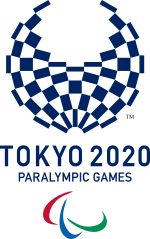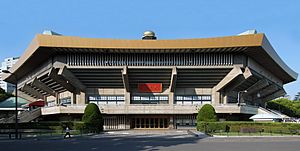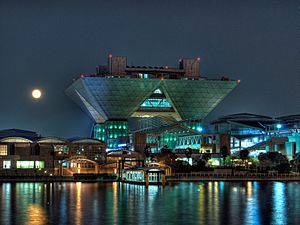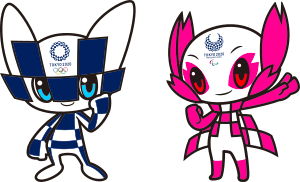2020 Summer Paralympics facts for kids
 |
|||
| Host city | Tokyo, Japan | ||
|---|---|---|---|
| Motto | United by Emotion (Japanese: 感動で、私たちはひとつになる, Hepburn: Kandō de, watashi-tachi wa hitotsu ni naru) (only the English version will be used during the Games) | ||
| Athletes | 4400 (expected) | ||
| Events | 540 in 22 sports | ||
| Opening | 24 August 2021 | ||
| Closing | 5 September 2021 | ||
| Opened by |
Emperor of Japan (expected)
|
||
| Stadium | Japan National Stadium | ||
| Summer | |||
|
|||
| Winter | |||
|
|||
The 2020 Summer Paralympics are a huge international sports event. They are for athletes with disabilities. The International Paralympic Committee (IPC) organizes these games.
These games are the 16th Summer Paralympic Games. They will happen in Tokyo, Japan. The dates are from August 24 to September 5, 2021. They were first planned for 2020. But they were moved because of the COVID-19 pandemic. This was the first time the Paralympics were ever postponed. Even though they are in 2021, they are still called the "2020 Summer Paralympics."
Tokyo has hosted the Paralympics before. This happened in 1964. That was also when Tokyo hosted the 1964 Summer Olympics.
Two new sports will join the Paralympics this year. They are badminton and taekwondo. They are replacing sailing and 7-a-side football.
Contents
Getting Ready for the Games
Making Tokyo Accessible
Before the 2016 Paralympics ended, Tokyo's Governor, Yuriko Koike, wanted to make the city easier to move around in. This was a special project for the games. She talked about narrow roads and small doorways. These were challenges that needed fixing. She also suggested moving power lines underground. This would help make roads wider.
Helping Out: Volunteers
In September 2018, people could apply to be volunteers. They could help at the Olympic and Paralympic Games. By January 2019, over 186,000 people had applied! Interviews started in February 2019. Training for volunteers began in October 2019.
Volunteers at the sports places are called "Field Cast." Those helping in the city are "City Cast." These names were chosen by the people who applied to volunteer.
Shiny Medals for Winners
In 2016, a group suggested making medals from recycled materials. This was like what Rio did for their games. A petition also asked for recycled medals. It got 10,000 signatures.
So, the medals for the 2020 Olympics and Paralympics are made from recycled metals. The organizers started a program to collect old electronics. People could donate old mobile phones. They needed to collect a lot of metal. This included gold, silver, and bronze. By November 2018, they had enough bronze. They expected to have enough gold and silver by March 2019.
The medals have a cool design. On one side, it looks like a folding Japanese fan. The center of the fan shows athletes bringing people together. It doesn't matter where they are from. Different textures on the fan show rocks, flowers, wood, leaves, and water. The Tokyo 2020 Paralympics logo is also there.
The other side also has a fan pattern. It says "Tokyo 2020 Paralympic Games" in English. It also has "Tokyo 2020" in English Braille. This helps people who cannot see. The side of the medal shows the event name. It also has one, two, or three circles. These circles tell you if it's gold, silver, or bronze. The ribbons also have special raised dots. This helps visually impaired athletes know which medal they have by touch.
The Paralympic Torch
The torches for the Olympic and Paralympic flames are special. They are made from aluminum. This aluminum comes from temporary houses. These houses were in Fukushima. More than 10,000 pieces of aluminum will be used. Organizers asked local towns for houses that were no longer used. In December 2018, the relay's slogan was announced. It is "Share Your Light."
The Torch Relay Journey
The path for the torch relay was announced in November 2019. There will be a special "Heritage Flame Celebration." This will be held in Stoke Mandeville. Flame lighting festivals will happen in 43 of Japan's 57 prefectures. These will be from August 13 to 17, 2020.
Torch relays will then run from August 18 to 21. They will go through four prefectures. These prefectures will host Paralympic events. The flames from all the festivals will come together in Tokyo. This will happen on August 21. Then, the Paralympic Flame will be officially lit. The last four days of the relay will be in Tokyo. The torch relay will go through similar places as the 2020 Summer Olympics torch relay.
The Games Themselves
Sports and Events
There will be 540 events at the 2020 Summer Paralympics. These events are in 22 different sports. Cycling events are split into two types: road and track.
Some team sports are for both men and women. These include goalball, sitting volleyball, and wheelchair basketball. Wheelchair rugby is a mixed event. 5-a-side football is only for male players. Some sports have new events or ways of grouping athletes.
 Archery (9 events)
Archery (9 events) Athletics (168 events)
Athletics (168 events) Badminton (14 events)
Badminton (14 events) Boccia (7 events)
Boccia (7 events) Cycling (51 events)
Cycling (51 events)
 Equestrian (11 events)
Equestrian (11 events) Football 5-a-side (1 event)
Football 5-a-side (1 event) Goalball (2 events)
Goalball (2 events) Judo (13 events)
Judo (13 events) Paracanoe (9 events)
Paracanoe (9 events) Paratriathlon (8 events)
Paratriathlon (8 events) Powerlifting (20 events)
Powerlifting (20 events) Rowing (4 events)
Rowing (4 events) Shooting (13 events)
Shooting (13 events) Sitting volleyball (2 events)
Sitting volleyball (2 events) Swimming (146 events)
Swimming (146 events) Table tennis (31 events)
Table tennis (31 events) Taekwondo (6 events)
Taekwondo (6 events) Wheelchair basketball (2 events)
Wheelchair basketball (2 events) Wheelchair fencing (16 events)
Wheelchair fencing (16 events) Wheelchair rugby (1 event)
Wheelchair rugby (1 event) Wheelchair tennis (6 events)
Wheelchair tennis (6 events)
New Sports Added
In January 2014, the IPC started looking for new sports. They wanted to add them to the Paralympic program. Some sports that wanted to join were badminton and taekwondo.
On January 31, 2015, the IPC announced the new sports. Badminton and taekwondo were officially added for 2020. They took the place of 7-a-side football and sailing. These two sports were removed because not enough countries played them.
Where the Games Will Be Held: Venues
The games will take place at many different locations. These are called venues. Here are some of the main places where the Paralympic events will happen:


Heritage Zone Venues
- New National Stadium – This is where athletics will be held. It's also where the Opening and Closing ceremonies will take place.
- Nippon Budokan – This venue will host Judo.
- Tokyo Equestrian Park – This park is for Equestrian events.
- Tokyo International Forum – Powerlifting will happen here.
- Tokyo Metropolitan Gymnasium – This gym will host Table tennis.
- Yoyogi National Stadium – This stadium will be used for Badminton and Wheelchair rugby.
Tokyo Bay Zone Venues
- Aomi Urban Sports Venue – This is for Football 5-a-side.
- Ariake Arena – This will be the main venue for Wheelchair basketball.
- Ariake Tennis Park – Wheelchair tennis will be played here.
- Dream Island Archery Park – This park is for Archery.
- Makuhari Messe – This large center will host many sports. These include Goalball, Sitting volleyball, Taekwondo, and Wheelchair fencing.
- Odaiba Marine Park – This park is for Paratriathlon.
- Olympic Aquatics Centre – This center is where Swimming events will be held.
- Olympic Gymnastics Centre – This center will host Boccia.
- Sea Forest Waterway – This waterway is for Rowing and Paracanoe.
Venues Outside the Main Area
- Musashino Forest Sports Plaza – This venue will host early wheelchair basketball games.
- Asaka Shooting Range – This range is for Shooting events.
- Izu Velodrome – This track is for track cycling.
- Fuji Speedway – This famous race track will host road cycling.
Other Important Places
- Harumi Futo Paralympic Village – This is where the athletes will stay.
- Tokyo Big Sight Conference Tower – This building will be the main center for media and broadcasters.
Countries Taking Part
Many countries will send athletes to the Paralympics. As of late 2020, 97 National Paralympic Committees (NPCs) had qualified. Guyana will be competing in the Paralympic Games for the very first time! The Solomon Islands will also be there for their second time.
In 2019, the World Anti-Doping Agency (WADA) banned Russia from international sports for four years. This was because the Russian government changed lab data. Because of this, some Russian athletes can still compete. But they will do so under a neutral name, not representing Russia. They cannot compete in team sports. These athletes will represent the Russian Paralympic Committee (RPC).
Promoting the Games
The Official Logo
The logos for the 2020 Olympics and Paralympics were shown in April 2016. The Paralympic logo looks like a hand fan inside a circle. It has a blue and white checkerboard pattern. This design shows Japan's elegant and sophisticated style. This new logo replaced an older one. The first logo was removed because some people said it looked too much like another logo from Belgium.
Meet the Mascots
The mascots for the Tokyo Games were chosen by public vote. The winning mascot for the Paralympics is named Someity. Someity has pink checkerboard patterns. These patterns are inspired by the official logo and cherry blossom flowers. Someity is calm but strong. It loves nature and can even talk to the wind! The names for both the Olympic and Paralympic mascots were announced in July 2018.
Animated Stories
Japan's public TV station, NHK, made a series of short cartoons. They are called Animation x Paralympic: Who Is Your Hero? Each cartoon shows a different Paralympic sport. They are made by famous anime and manga creators. Sometimes, they even feature characters from popular shows or real-life athletes!
See also
 In Spanish: Juegos Paralímpicos de Tokio 2020 para niños
In Spanish: Juegos Paralímpicos de Tokio 2020 para niños



